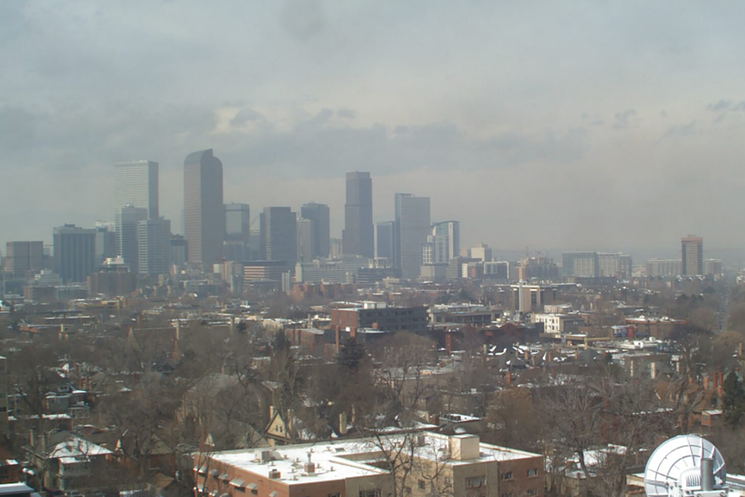
CDPHE

Audio By Carbonatix
As ozone pollution in the Denver metro area took another turn for the worse this week, a federal judge ruled that the Environmental Protection Agency is violating clean-air laws by delaying a key decision on local air-quality standards.
In a ruling issued Monday, July 22, Judge John Kane of the U.S. District Court in Denver found that EPA Administrator Andrew Wheeler has “failed to perform a nondiscretionary duty” by delaying a determination regarding the metro area’s classification under the National Ambient Air Quality Standards for ozone pollution. The partial summary judgment came as a result of a lawsuit filed by environmental group WildEarth Guardians against Wheeler and the EPA earlier this year. Court filings show that the agency didn’t object to Kane’s ruling.
“This is the Trump administration’s EPA on full display,” says Jeremy Nichols, WildEarth Guardians’ climate and energy program director. “They just refuse to comply with the law. They’re willing to keep dragging their feet to the point where they get ruled against in court, because they don’t want to comply. They don’t want to have to clamp down.”
The group’s lawsuit revolves around a regulatory decision that was due to be made by the EPA earlier this year. For more than a decade now, a nine-county region known as the Denver Metro/North Front Range Nonattainment Area has exceeded federal standards for ozone pollution that were set by the agency in 2008. The state faced a January 2019 deadline to bring the area’s air quality into compliance, or be reclassified from “moderate nonattainment” to “serious nonattainment,” which would require regulators to impose stricter regulations on polluters. The state missed the deadline – air pollution in Denver got worse last year, not better – but the EPA’s attainment determination hasn’t yet been made.
“This is a simple finding that they need to make,” says Nichols. “It’s not a complicated action. It’s very clear that Colorado failed to meet the 2008 ozone air-quality standards, so this shouldn’t be happening. It’s a sign of how nuts the Trump administration is, and how they just refuse to take their legal duties seriously. And unfortunately, it’s our clean air that suffers.”
The EPA did not respond directly to questions regarding the attainment determination and when it’s expected to be made. “EPA supports the state’s efforts to address ozone issues along the Front Range,” EPA Region 8 spokesperson Lisa McClain-Vanderpool said in an email. “The Agency does not comment on ongoing litigation.”
Monday’s court ruling came as ozone pollution in Denver began to rise to its highest level of the year so far, reaching an eight-hour Air Quality Index of 133 on Tuesday, July 23. Parts of metro Denver reached one-hour ozone concentrations of 100 parts per billion on Monday and Tuesday, according to state air-quality data – levels that are considered “unhealthy” for all groups on the AQI scale.
High levels of ozone pollution are expected to continue along the Front Range this week. In a forecast issued this morning, officials with the Colorado Department of Public Health and Environment warned that “active children and adults, and people with lung disease, such as asthma, should reduce prolonged or heavy outdoor exertion” in the afternoon and evening, when ozone levels are typically at their daily peak.
Ground-level ozone is a so-called criteria pollutant that can cause a wide variety of negative health effects, from acute symptoms such as coughing and shortness of breath to chronic conditions like asthma and emphysema. It’s formed primarily by the interaction between sunlight and “ozone precursors” like volatile organic compounds and nitrogen oxides. In Denver, studies have shown that the two largest sources of ozone-forming pollutants are motor vehicles and oil and gas facilities along the Front Range, both of which can account for up to 40 percent of local ozone production on a given day.
A reclassification to serious nonattainment by the EPA would force CDPHE regulators to subject those emissions sources to a higher degree of scrutiny and regulation. In March, Governor Jared Polis withdrew a state request, made by his predecessor John Hickenlooper, for an extension to meet the federal ozone standards. “There’s more we can do to protect our air quality and health, and we should do it sooner not later,” Polis said at the time.
Even if the extension hadn’t been withdrawn, it would have expired last week. Nichols and WildEarth Guardians, along with other environmental groups, have launched a campaign to pressure the CDPHE to act now, without waiting for the Trump administration to finally tell state officials what they already know.
“Having the backing of the EPA’s finding forces them to [act], but the state shouldn’t have to be forced to clean up the air,” Nichols says. “They could start to implement more rigorous permitting; they could start to put emissions on track. They could be taking some actions now.”